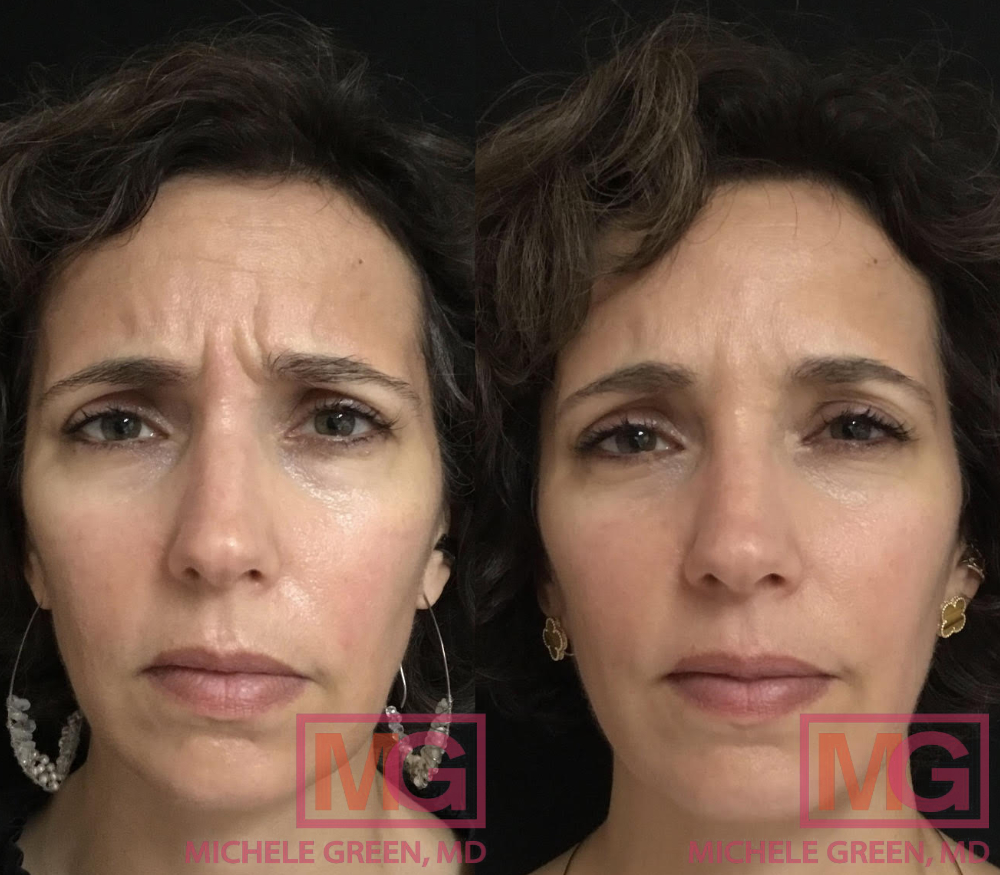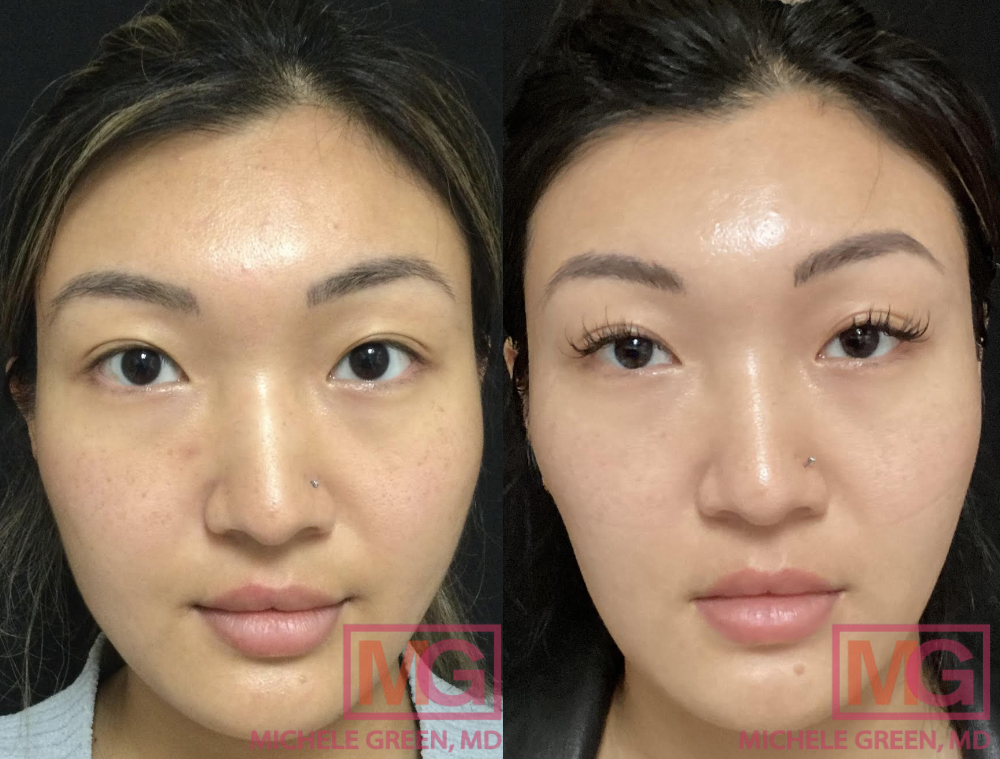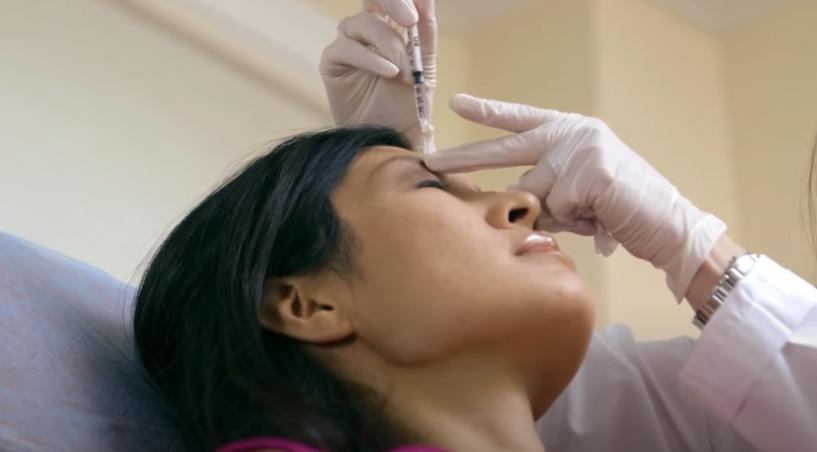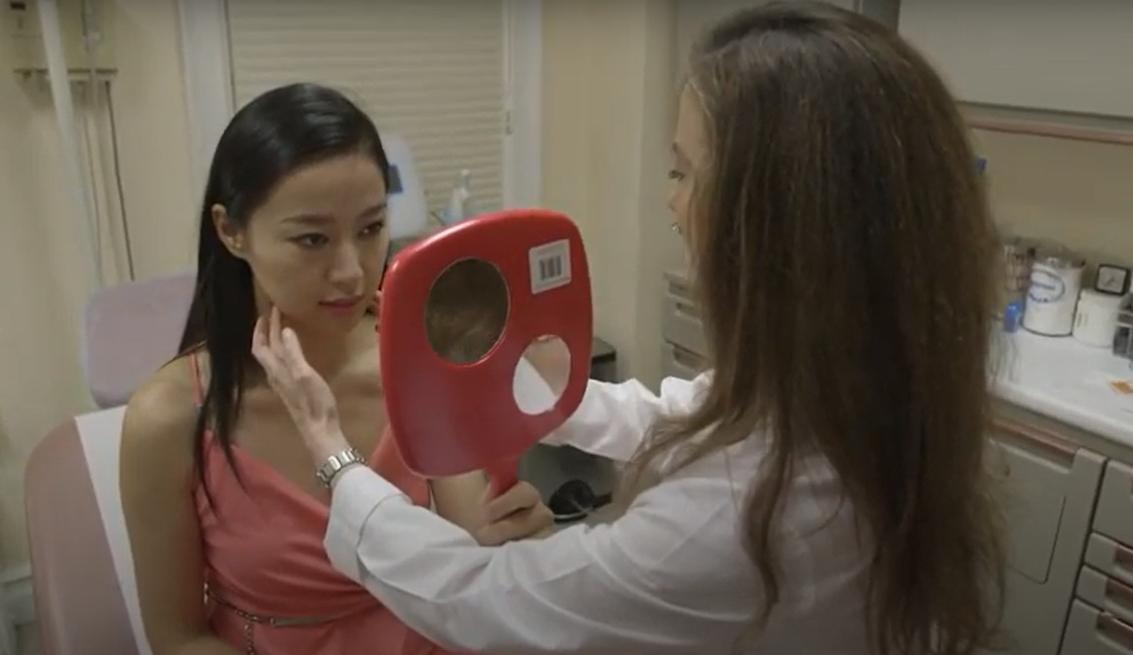Can You Workout After Botox?
Fine lines and wrinkles are some of the most common concerns patients present with when it comes to addressing signs of aging. With age, the rate of new collagen production decreases and existing collagen gradually depletes. Because collagen is the protein in our skin that provides structure, this loss of collagen over time leads to skin laxity, fine lines, and wrinkles. Deep wrinkles that form on the forehead, glabella (“the elevens”), and around the eyes (crow’s feet) are due to repeated muscle movements along with loss of collagen over time. These wrinkles are referred to as dynamic wrinkles. Thankfully, the appearance of dynamic wrinkles can be softened and eliminated with non-invasive and non-surgical injectable treatment called Botox.
In the world of dermatology, Botox, also known as botulinum toxin, is the most popular cosmetic treatment in the United States for its safe and effective anti-aging properties. With minimal to no downtime, Botox treatments are fast and effective as a lot of patients schedule their Botox appointments on their lunch break. As opposed to cosmetic surgical procedures, patients can return to normal daily activities such as working and running errands after Botox injections. However, there are very few aftercare instructions that must be followed after Botox, including avoiding strenuous exercise for 24 hours following Botox treatments.
With Botox and Dysport treatments, or any neuromodulators such as Xeomin or Jeuveau, it is important to refrain from exercise for 24 hours and remain upright for at least four hours after the injections. This means no strenuous exercises, including yoga with inversions, pilates, swimming, and weight lifting. When you consult with internationally renowned, board-certified cosmetic dermatologist Dr. Michele Green for your Botox treatments, she will carefully develop your cosmetic injectable treatment plan and provide you with all pertinent aftercare information. Dr. Green has over 25 years of experience providing some of the most discerning men and women from around the world with facial rejuvenation treatments. She is consistently voted as one of New York City’s best physicians by Castle Connolly, New York Magazine, and Super Doctors, and offers what is described as the “best Botox in New York”.
What is Botox?
Botox® Cosmetic is an injectable medication commonly used to treat and prevent signs of aging such as fine lines and wrinkles. Since its FDA approval in 2002, this cosmetic procedure has skyrocketed in popularity and became the number one non-invasive cosmetic injectable in the United States. Botox is derived from botulinum toxin type A, a neurotoxin produced by the bacterium Clostridium botulinum. Botox® Cosmetic is a brand name for the injectable medication manufactured by the pharmaceutical company Allergan. The generic name for Botox is OnabotulinumtoxinA. Botox is currently FDA-approved to treat moderate to severe frown lines, crow’s feet, and forehead lines. Botox can also be used to treat neck lines and non-surgical jaw slimming as well as lip flip. The indication for Botox has also expanded to treat certain medical conditions, such as symptoms of hyperhidrosis, TMJ, and migraines as well as blepharospasm and cervical dystonia.
How does Botox work?
Botox is a neuromodulator: its active ingredient, botulinum toxin type A, is a neurotoxin (a protein) that blocks nerve signals or neurotransmitters that tells the muscles to contract. This temporarily paralyzes the muscle at the injection site, preventing repeated muscle movements that lead to dynamic wrinkles. Dynamic wrinkles refer to wrinkles caused by repeated muscle contractions, such as frown lines (“the elevens”), smile lines around the eyes (crow’s feet), and forehead lines. When Botox is injected by an expert injector such as Dr. Michele Green, it reduces the appearance of wrinkles by smoothing out the surface of the skin.
It takes about one week to start noticing the effects of Botox, and about two weeks to see the full effects. For this reason, Dr. Green recommends scheduling a follow-up appointment two weeks after Botox injections to check if any touch ups are necessary.
Do Facial Exercises help improve Botox?
Some patients may have been instructed by their dermatologist or injector to practice facial exercises to improve the effects of Botox. The validity of this post-Botox instruction is still up for debate today. A study conducted at Northwestern University and published in the Journal of the American Academy of Dermatology (JAAD) in 2018 showed that of the 25 female participants, those who practiced facial exercises after Botox injections observed the positive effects of Botox one day earlier than the participants who did not perform facial exercises. Whether constantly using the injected muscles after Botox will optimize the uptake of the neurotoxin molecule into the neuromuscular junction requires more research. In general, it is not necessary to do exercise facial muscles after Botox as patients who don’t practice facial exercises post-treatment still have great Botox results. However, it is also not necessary to prevent movement of the injected muscle after Botox. You can continue with normal facial expressions immediately after Botox injections, including smiling, frowning, and raising your eyebrows.

How long after Botox can you workout?
It is best to refrain from strenuous exercise for 24 hours after Botox treatment. Exercising increases your heart rate, which increases circulation throughout the body. While this is normally beneficial for your cardiovascular system and overall health and wellness, it is not recommended for 24 hours after Botox. This increased blood flow may migrate the injected Botox to surrounding areas and can potentially lead to unwanted side effects such as drooping eyebrows and eyelids. Dr. Green also recommends refraining from running on the treadmill or aerobic exercise for four hours. Other activities to avoid include saunas, hot yoga, tanning booths, and hot tubs, as exposure to heat causes increased blood flow and is associated with an increased risk of bruising after Botox. After 24 hours have elapsed, you can continue any strenuous activities such as cycling, hiking, running, and yoga.
Why can’t you exercise after Botox?
There are a few reasons why you should avoid strenuous exercise after Botox treatment. First, exercising increases your heart rate and therefore circulation. This increased blood flow and blood pressure can not only contribute to bruising and swelling, but it can also cause the injected Botox to migrate to surrounding areas away from the injection site. This leads to temporary paralysis of the surrounding muscles and can lead to unwanted side effects such as drooping eyebrows and eyelids.
Second, one of the most important post-Botox instructions is to keep your head upright for four hours. This means if you have to bend to pick up something from the ground, plié like a ballerina instead of bending with your back. This also means you cannot lie down for four hours after Botox injections, meaning avoid sleeping or going to the dentist. This is to avoid unwanted migration of the Botox post-treatment. Exercises like yoga, which require inversions like the downward dog position, may contribute to the Botox migrating outside of the injected area and affect the surrounding muscles.

Lastly, it is advised that patients avoid putting pressure on the treated areas for 72 hours post-treatment, including receiving facial massages. This is also due to the possibility that the pressure can migrate the Botox to the surrounding muscles. Certain activities like swimming and cycling may require you to wear tight-fitting head gear that put pressure on the popular treatment areas like the forehead. Furthermore, you may subconsciously apply pressure to the injected areas while wiping off sweat during strenuous exercise.
Botox can diffuse for several hours after its injection into an area of the face. When injected into the forehead, glabella (frown lines), or eyes (crow’s feet), Botox could potentially diffuse into the small muscles of the upper eyelid. Dysport and Xeomin, other neuromodulators similar to Botox, have different diffusion profiles and can diffuse to a greater area than Botox.
We advise patients to exercise before the scheduled Botox appointment. By exercising before the cosmetic injections, you avoid any risk of migration and unwanted side effects while feeling great. Exercising before Botox helps avoid feeling guilty for skipping the gym that day.
Does working out make Botox wear off faster?
Generally, the effects of Botox injections lasts three to four months on average. However, it can last anywhere from two to six months. Botox is temporary because it is made of a protein derived from the bacterium Clostridium botulinum, and our bodies naturally break down this protein once it is injected into the targeted muscle. There are currently no published studies that suggest exercising makes the effects of Botox wear off quicker, although some dermatologists may share anecdotal evidence that it does. The thought behind this is that those who exercise have a faster metabolic rate and therefore break down the Botox quicker. Again, there is currently no clinically studied evidence that suggests working out will make the Botox wear off faster. If the effects of Botox is not lasting, it is likely due to genetics or not enough units of Botox were injected into the treated area.

Can I lift weights after Botox?
Patients should wait 24 hours after Botox to participate in strenuous activities like lifting weights. Weight lifting increases heart rate and blood pressure which contribute to bruising and swelling after any injections. This increased blood flow can also cause the injected Botox to migrate to surrounding areas, causing temporary paralysis of the surrounding muscles and increasing the risk of unwanted side effects such as drooping eyebrows and eyelids. Furthermore, weight lifting activities such as deadlifts and bench presses require you to lie down or bend over, which goes against the post-Botox instruction of keeping your head upright for four hours post-treatment.
Can you do cardio after Botox?
It is highly encouraged to avoid cardio exercises for 24 hours after Botox injections. Cardio is short for cardiovascular training. As the name suggests, cardio involves exercises that elevate the heart rate to strengthen the heart and lungs. Increased circulation after Botox injections can contribute to bruising and swelling, as well as unwanted migration and diffusion of the Botox into surrounding muscles. In the worst case scenario, this can temporarily paralyze unwanted muscles that can lead to drooping eyebrows and eyelids. Therefore, it is best to avoid cardio for 24 hours after Botox to give it time to settle into the injected areas.
Can you workout before Botox?
Yes! You can workout a few hours before your Botox appointment. If daily exercise is an essential part of your health and wellness, it is not necessary to skip exercising for the entire day. Simply, schedule your exercise prior to the Botox appointment so you can avoid worrying about correctly following the aftercare instructions.
There are, however, some things you should avoid before Botox injections. Avoid blood thinners like aspirin, Coumadin, and Warfarin for two weeks prior to Botox treatment (make sure to clear it with the prescribing physician) to prevent bruising and swelling. Avoid supplements like fish oil, vitamin E, and Ginko Biloba as they also contain blood thinning properties and can increase the risk of bruising and swelling after injections. Avoid alcohol for at least 24 hours prior to Botox treatment as alcohol can increase the risk of bleeding and bruising.
How long should you wait to workout after Botox?
After Botox injections, you should wait 24 hours before any strenuous exercise to avoid bruising, swelling, and diffusion of the Botox into unwanted areas. The increased blood flow from exercising can not only contribute to bruising and swelling after Botox injections, but it can also cause the Botox to migrate away from the injection site into the surrounding muscles. In a worst case scenario, this can cause unwanted eyelid and eyebrow drooping.
You can, however, participate in light walking, light gardening, and yoga without inversions after Botox injections as long as you are not significantly increasing your heart rate or bending over. If you have any reservations about what to do after Botox, be sure to ask your provider or injector.

Can you workout 12 hours after Botox?
The golden rule for after Botox is to wait 24 hours before resuming strenuous exercises such as running and weight lifting. This gives enough time for the Botox to fully settle and prevent it from migrating to other areas. In the first 24 hours after Botox injections, you can participate in light walking, light gardening, and yoga without inversions as long as you are keeping your head upright for four hours and avoiding pressure on the injected areas. You can also workout a few hours before the Botox appointment so you can avoid worrying about exercising afterwards.
How can I get started with Botox treatments today?
Botox treatments are quick, safe, and effective in treating signs of aging such as forehead wrinkles, glabellar lines, and crow’s feet. Botox is also beneficial in non-surgical jaw reduction, treating symptoms of TMJ and migraines, as well as treating hyperhidrosis or excessive sweating. With its versatility, it is no wonder that Botox is the number one non-invasive cosmetic treatment. Botox is widely available in the United States by dermatologists, plastic surgeons, and even MedSpas and clinics. It is important to note, however, that the risk of side effects with any injections including Botox is significantly reduced when performed by an experienced, board-certified dermatologist like Dr. Michele Green than inexperienced injectors at MedSpas.
With over 25 years of experience in cosmetic dermatology, Dr. Michele Green has been utilizing Botox to reverse aging for patients from all over the world. With her gentle touch and artful skills, Dr. Green is able to reverse the aging process and create a more youthful, rejuvenated complexion. Although Botox has historically been used to treat existing wrinkles, its purpose has evolved to include preventative measures. Patients in their 20s and 30s have been seeking Dr. Green’s expertise in preventing signs of aging. When you come to Dr. Green for Botox treatments, she will carefully assess your skin and aesthetic goals to personalize a treatment plan that works best for you.
In her discreet New York City private dermatology office, Dr. Green has been utilizing an array of cosmetic treatments from dermal fillers, Botox, chemical peels, non-invasive skin tightening, and various lasers to achieve rejuvenated and youthful complexions. As an expert in injectables, lasers, and skincare, Dr. Green is consistently voted as one of New York’s best physicians by Castle Connolly, New York Magazine, and Super Doctors for her holistic approach and “less is more” philosophy when it comes to anti-aging treatments. Please contact our office today or call 212-535-3088 to learn more about whether Botox treatments, or a combination of Botox injections with Dermal Fillers such as Juvederm, Kybella, Radiesse or Restylane may be best suited for your anti-aging and aesthetic goals.
 212-535-3088
212-535-3088